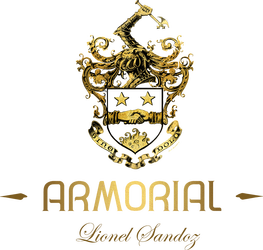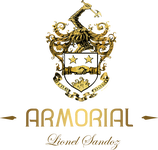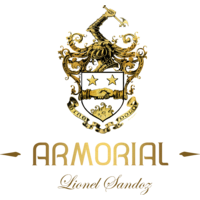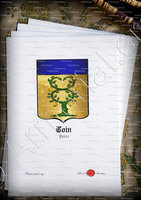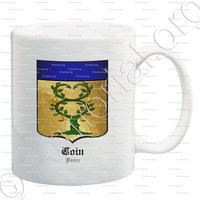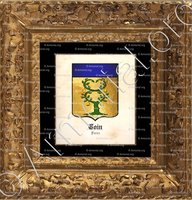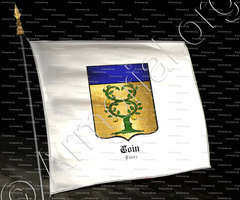DESCRIPTION
COIN
Forez
France
Armoiries;
" D'or, à un cognassier de deux branches passées en double sautoir de sinople, fruité d'or, au chef d'azur. "
Sources héraldiques :
- Armorial général d’Europe, par J.B. Rietstap (Gouda, 1861).
- Armorial d'Europe par J.B. Rietstap (Gouda, 1884, Berlin, 1934) (Gouda, 1887, Berlin 1937).
- Armorial général J.B. Rietstap, illustré par Victor et Henri Rolland (1903-1926). Colorisé par Lionel Sandoz (1993-2002).
Symbolique du blason:
Les armoiries "parlantes" de la famille "Coin" utilisent le cognassier pour symboliser phonétiquement le nom de famille, ajoutant ainsi une dimension visuelle et symbolique forte à leur blason, tout en évoquant des valeurs positives et une identité historique distincte.
- Ce blason peut être interprété comme un symbole de richesse et d'abondance (or et fruits d'or), de croissance et de prospérité (cognassier et branches en sautoir), avec une forte composante de loyauté et de justice (chef d'azur). Les branches en double sautoir ajoutent une dimension de protection et de résilience.
Origine et étymologie:
Le nom de famille "Coin" a plusieurs origines possibles, souvent dépendant de la région et du contexte historique. Il peut dériver de toponymes désignant des coins de rues ou de champs, ou être lié à un terme professionnel désignant un artisan travaillant avec des coins en métal ou des pièces de monnaie. En ancien français, "coin" signifiait aussi un angle ou une pièce de monnaie. Des variations régionales, influencées par les dialectes et les coutumes locales, ont également pu jouer un rôle dans l'évolution de ce nom.
____________________
COIN
Forez
France
Coat of Arms:
"Or, a quince tree with two branches crossed in saltire vert, fruited or, a chief azure."
Heraldic Sources:
Armorial général d’Europe, by J.B. Rietstap (Gouda, 1861).
Armorial d'Europe by J.B. Rietstap (Gouda, 1884, Berlin, 1934) (Gouda, 1887, Berlin 1937).
Armorial général J.B. Rietstap, illustrated by Victor and Henri Rolland (1903-1926). Colored by Lionel Sandoz (1993-2002).
Symbolism of the Coat of Arms:
The "speaking" arms of the "Coin" family use the quince tree to phonetically symbolize the family name, adding a strong visual and symbolic dimension to their coat of arms, while also evoking positive values and a distinct historical identity.
This coat of arms can be interpreted as a symbol of wealth and abundance (gold and golden fruits), growth and prosperity (quince tree and saltire branches), with a strong component of loyalty and justice (azure chief). The double saltire branches add a dimension of protection and resilience.
Origin and Etymology:
The surname "Coin" has several possible origins, often depending on the region and historical context. It may derive from toponyms referring to street corners or field corners, or be linked to a professional term denoting an artisan working with metal wedges or coins. In Old French, "coin" also meant an angle or a coin. Regional variations, influenced by local dialects and customs, may have also played a role in the evolution of this name.
______________________
COIN
Forez
Francia
Stemma;
" D'oro, a un cotogno con due rami incrociati di verde, fruttato d'oro, col capo d'azzurro. "
Fonti araldiche:
Armorial général d’Europe, di J.B. Rietstap (Gouda, 1861).
Armorial d'Europe di J.B. Rietstap (Gouda, 1884, Berlino, 1934) (Gouda, 1887, Berlino 1937).
Armorial général J.B. Rietstap, illustrato da Victor e Henri Rolland (1903-1926). Colorato da Lionel Sandoz (1993-2002).
Simbolismo dello stemma:
Le armi "parlanti" della famiglia "Coin" utilizzano il cotogno per simboleggiare foneticamente il nome della famiglia, aggiungendo così una forte dimensione visiva e simbolica al loro stemma, evocando al contempo valori positivi e un'identità storica distinta.
Questo stemma può essere interpretato come un simbolo di ricchezza e abbondanza (oro e frutti d'oro), di crescita e prosperità (cotogno e rami incrociati), con una forte componente di lealtà e giustizia (capo d'azzurro). I rami incrociati aggiungono una dimensione di protezione e resilienza.
Origine ed etimologia:
Il cognome "Coin" ha diverse possibili origini, spesso dipendenti dalla regione e dal contesto storico. Può derivare da toponimi che designano angoli di strade o campi, o essere legato a un termine professionale che indica un artigiano che lavora con zecche di metallo o monete. Nell'antico francese, "coin" significava anche un angolo o una moneta. Varianti regionali, influenzate dai dialetti e dalle usanze locali, potrebbero aver avuto un ruolo nell'evoluzione di questo nome.
______________________
COIN
Forez
Frankreich
Wappen;
"In Gold, ein Quittenbaum mit zwei Zweigen in grünem Doppelkreuz, befruchtet mit Gold, mit einem blauen Schildhaupt."
Heraldikquellen:
Allgemeines Wappenbuch von Europa, von J.B. Rietstap (Gouda, 1861).
Wappenbuch von Europa von J.B. Rietstap (Gouda, 1884, Berlin, 1934) (Gouda, 1887, Berlin, 1937).
Allgemeines Wappenbuch J.B. Rietstap, illustriert von Victor und Henri Rolland (1903-1926). Koloriert von Lionel Sandoz (1993-2002).
Symbolik des Wappens:
Das "sprechende" Wappen der Familie "Coin" verwendet den Quittenbaum, um den Familiennamen phonetisch zu symbolisieren, und verleiht dem Wappen eine starke visuelle und symbolische Dimension, die positive Werte und eine deutliche historische Identität evoziert.
Dieses Wappen kann als Symbol für Reichtum und Überfluss (Gold und goldene Früchte), Wachstum und Wohlstand (Quittenbaum und gekreuzte Zweige) sowie als starke Komponente von Loyalität und Gerechtigkeit (blaues Schildhaupt) interpretiert werden. Die doppelt gekreuzten Zweige fügen eine Dimension von Schutz und Widerstandskraft hinzu.
Herkunft und Etymologie:
Der Familienname "Coin" hat mehrere mögliche Ursprünge, die oft von der Region und dem historischen Kontext abhängen. Er kann von Ortsnamen stammen, die Ecken von Straßen oder Feldern bezeichnen, oder mit einem Berufsterminus verbunden sein, der einen Handwerker bezeichnet, der mit Metallecken oder Münzen arbeitet. Im Altfranzösischen bedeutete "coin" auch eine Ecke oder eine Münze. Regionale Variationen, beeinflusst von Dialekten und lokalen Bräuchen, könnten ebenfalls eine Rolle bei der Entwicklung dieses Namens gespielt haben.
______________________
PARTAGEZ SUR LES RÉSEAUX SOCIAUX
LES AVIS
Il n'y a aucune note pour le moment. Soyez le premier à évaluer !
DONNEZ UNE NOTE
